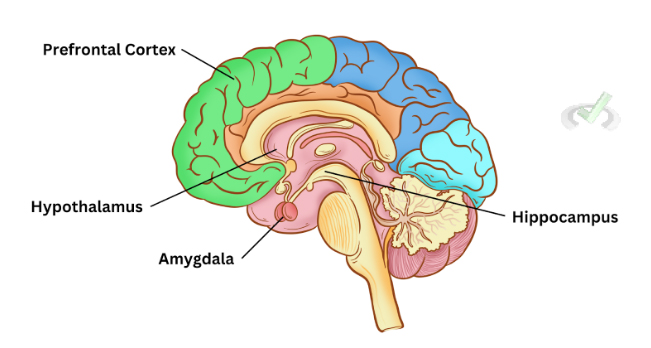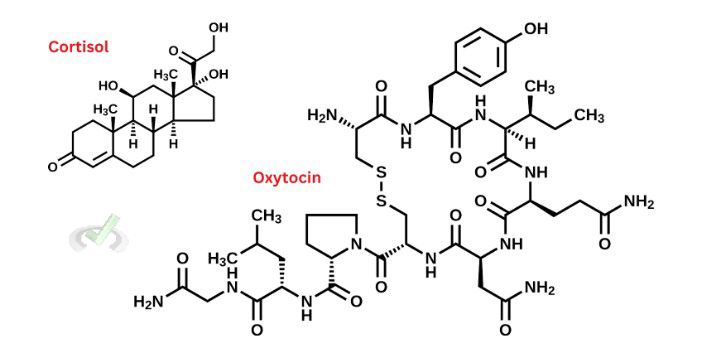Emotions are complex reactions that involve both the mind and body. Understanding the biology behind emotions helps us see how our feelings are connected to brain functions and bodily responses. These biological mechanisms drive our emotional experiences, influencing how we think and act.
Imagine you are walking in the woods and suddenly see a snake. Your heart races, your muscles tense, and you feel a rush of fear.
These reactions happen because your brain and body work together to keep you safe. By studying the biology of emotion, we can understand why our bodies react this way and how our brains control these responses.
I. Brain Structures Involved in Emotion

The brain is the central hub for processing emotions. Several structures play a role:
Amygdala
The amygdala is an almond-shaped cluster of neurons. It is crucial for detecting fear and preparing for emergency events. This structure is responsible for our fight-or-flight response.
When you encounter something scary, the amygdala sends a distress signal to the rest of the brain. This triggers the release of adrenaline. It increases your heart rate and prepares your muscles for action.
The amygdala also stores emotional memories. This is why certain smells or sounds can instantly bring back strong feelings.
Hippocampus
The hippocampus is involved in forming new memories. It works closely with the amygdala to process emotions.
When you experience something emotional, the hippocampus helps form a memory of that event. This is why emotional experiences are often remembered more vividly than neutral ones.
Prefrontal Cortex
The prefrontal cortex helps regulate emotions. It controls impulses and enables complex decision-making. It also allows you to think through your actions and manage your emotions.
When you feel angry, for example, the prefrontal cortex helps you decide whether to shout or stay calm. It is essential for emotional regulation and impulse control.
Hypothalamus
The hypothalamus links the nervous and endocrine systems via the pituitary glands. It helps regulate bodily functions such as temperature, hunger, and sleep. Moreover, it also regulates hormones that affect mood and stress, which play a role in emotional responses.
II. Neurotransmitters and Hormones
Emotions are influenced by chemicals in the brain called neurotransmitters and hormones. These substances help transmit signals between nerve cells and throughout the body.
Important Neurotransmitters

- Dopamine: Often called the "feel-good" neurotransmitter. It is linked to pleasure and reward. It is important in motivation and how we experience joy.
- Serotonin: This neurotransmitter helps regulate mood, sleep, and appetite. Low serotonin levels are linked with depression and anxiety.
- Norepinephrine: This chemical helps control alertness and arousal. It plays a role in the body's reaction to stress. It increases the heart rate and enhances blood circulation to the muscles.
Hormones Involved in Emotion

- Cortisol: Known as the "stress hormone." It is released in response to stress. It helps prepare the body for a fight-or-flight response. However, chronic stress can cause high cortisol levels and health problems. This includes a weakened immune system and high blood pressure.
- Oxytocin: Sometimes called the "love hormone." It is released during social bonding activities like hugging or breastfeeding. It promotes feelings of trust and connection.
III. Physiological Responses to Emotion
Emotions are not just mental experiences; they also cause physical changes in the body.
The Autonomic Nervous System
The autonomic nervous system (ANS) controls the body's functions without us having to think about it. It is divided into two parts:
- Sympathetic Nervous System: This system prepares the body for action. When you feel threatened, the sympathetic nervous system increases your heart rate. It also dilates your pupils and releases adrenaline.
- Parasympathetic Nervous System: This system helps the body calm down and return to a restful state after a stressful event. It slows the heart rate and promotes digestion.
The Fight-or-Flight Response
When you encounter danger, the fight-or-flight response is activated. This involves:
- Perception of Threat: The amygdala recognizes a threat and sends a signal to the hypothalamus.
- Release of Adrenaline: The hypothalamus activates the sympathetic nervous system. This leads to the release of adrenaline from the adrenal glands.
- Physiological Changes: Your heart rate increases, muscles tense, and you become more alert. These changes prepare you to either fight the threat or run away.
The Rest-and-Digest Response
Once the threat is gone, the parasympathetic nervous system aids the body return to a normal state:
- Calming Signals: The parasympathetic nervous system sends signals to slow the heart rate and reduce adrenaline levels.
- Relaxation: Your body begins to relax, digestion resumes, and you feel calm again.
IV. Bridge/Overlap
As we talked about earlier, understanding the biology of emotion helps us see how our emotions and physical health are connected. Let’s explore how these topics are intertwined with the biology of emotion.
Neuroanatomy
Neuroanatomy is the study of the structure and function of the nervous system. By learning about specific brain regions and pathways involved in emotion, we gain insight into how the brain functions. This understanding shows us how different parts of the brain work together to create emotional responses.
For example:
- Amygdala: Helps us feel emotions like fear.
- Hippocampus: Helps us remember emotional events.
- Prefrontal Cortex: Helps us control our emotions.
Knowing this can help us understand disorders that affect emotions, like anxiety and depression.
Endocrinology
Endocrinology is the study of hormones and how they control body functions. Hormonal imbalances can affect both emotional and physical health.
For instance:
- High cortisol levels from stress can cause high blood pressure and a weak immune system.
- Oxytocin and cortisol influence how we feel.
Understanding these hormones helps us manage stress and improve emotional well-being. It's also important for dealing with endocrine disorders that affect mood, like thyroid problems.
Behavioral Science
Behavioral science looks at how psychological methods can change physical responses. Techniques like cognitive-behavioral therapy (CBT) help people manage their emotions. It helps change how a person thinks and behaves.
For example, CBT can teach people to challenge negative thoughts that cause anxiety and depression. Knowing the link between psychological practices and changes in the brain can improve mental health treatments.
Pathophysiology
Pathophysiology studies how diseases affect the body. Chronic stress and poor emotional regulation can lead to health problems. This may include heart disease, diabetes, and a weak immune system.
Understanding the biological links helps create effective treatment plans. For example, stress management techniques can help lower the risk of stress-related diseases.
These techniques include mindfulness and physical activity. Such knowledge is crucial for making care plans that address mental and physical health.
V. Wrap Up/Key Terms
Let’s take this time to wrap up & concisely summarize what we covered above in the article!
Key Terms
- Amygdala: The brain's alarm system, crucial for fear and emergency response.
- Hippocampus: Links emotions with memories.
- Prefrontal Cortex: Regulates emotions and controls impulses.
- Hypothalamus: Connects the nervous system and endocrine system. It controls various bodily functions.
- Neurotransmitters: Dopamine (pleasure), serotonin (mood), norepinephrine (alertness).
- Hormones: Cortisol (stress), oxytocin (social bonding).
- Autonomic Nervous System: Sympathetic (fight-or-flight), parasympathetic (rest-and-digest).
- Fight-or-flight Response: The body's immediate reaction to danger. This involves adrenaline release and physiological changes.
- Rest-and-Digest Response: The body returns to a calm state after stress.
VI. Practice Questions
Sample Practice Question 1
What is the amygdala's role in the brain's response to fear?
A. It acts as the brain's alarm system, detecting fear and preparing for emergencies.
B. It regulates emotions and impulses.
C. It forms new memories.
D. It controls voluntary muscle movements.
Ans. A
The amygdala is the brain's alarm system. It detects fear and prepares for emergencies. Then, it triggers a distress signal that triggers adrenaline release. This prepares the body for action.
Sample Practice Question 2
What happens during the fight-or-flight response?
A. The heart rate decreases.
B. The sympathetic nervous system increases heart rate, dilates pupils, and releases adrenaline.
C. The body relaxes, and digestion resumes.
D. The parasympathetic nervous system activates to calm the body.
Ans. B
During the fight-or-flight response, the sympathetic nervous system increases heart rate, dilates pupils, and releases adrenaline. It prepares the body to either fight the threat or run away.







 To help you achieve your goal MCAT score, we take turns hosting these
To help you achieve your goal MCAT score, we take turns hosting these 





















 reviews on TrustPilot
reviews on TrustPilot